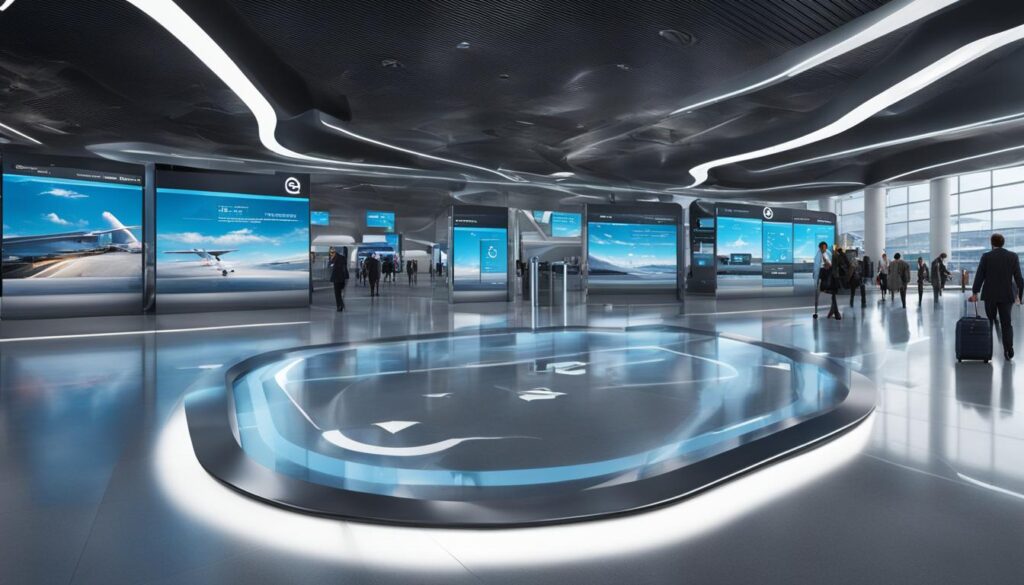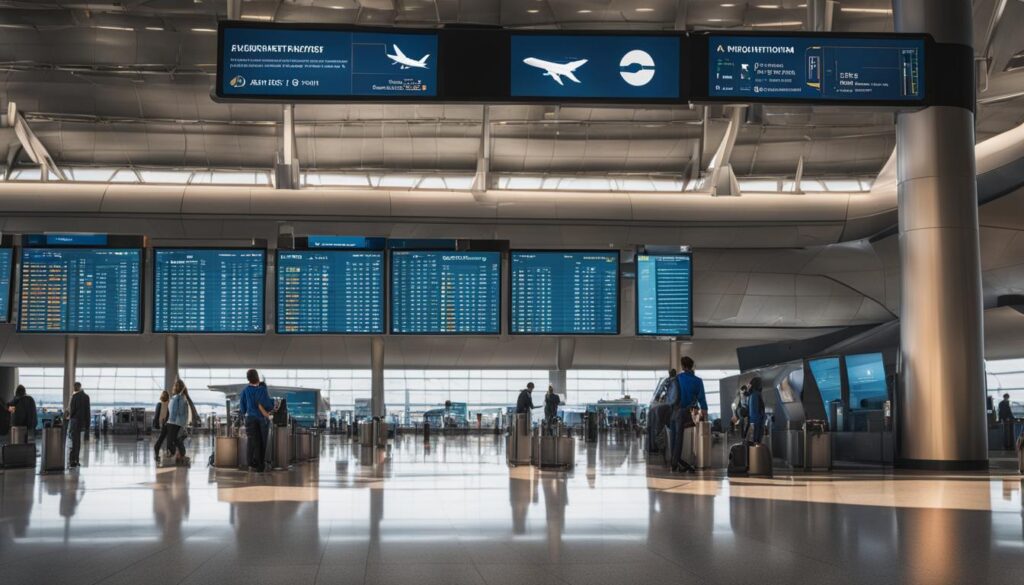Are you curious about how much it costs for airports to implement augmented reality (AR) technology? In this article, we will uncover the expenses associated with integrating AR in airports and explore the various applications and benefits it offers. From improving navigation and wayfinding to enhancing safety procedures, AR has the potential to transform the air travel industry. But what is the actual cost of this innovative technology? Let’s find out.
Contents
- 1 Benefits of Augmented Reality for Airports
- 2 Applications of Augmented Reality in Airports
- 3 Augmented Reality in Aviation Training and Simulated Experience
- 4 AR Implementation Case Study – China Southern Airlines
- 5 Conclusion
- 6 FAQ
- 6.1 How much does it cost for airports to use augmented reality?
- 6.2 What are the expenses of using augmented reality in airports?
- 6.3 What are the benefits of augmented reality for airports?
- 6.4 How is augmented reality currently being used in airports?
- 6.5 How much does augmented reality training cost for airports?
- 6.6 What is the future potential of augmented reality in air travel?
- 6.7 Can you provide an augmented reality implementation case study?
- 6.8 How can airports position themselves for success in the augmented reality air travel industry?
- 6.9 What is the impact of augmented reality on airport budgets?
- 7 Source Links
Key Takeaways:
- The cost of implementing augmented reality in airports varies depending on the specific applications and technologies involved.
- Expenses may include purchasing AR devices, developing custom software, training staff, and ongoing maintenance and support.
- The cost can range from a few thousand dollars to several hundred thousand dollars, depending on the scale and complexity of the implementation.
- Augmented reality offers benefits such as improved navigation, personalized content delivery, and enhanced safety procedures.
- Being an early adopter of AR technology in the air travel industry can provide a competitive edge and attract tech-savvy passengers.
Benefits of Augmented Reality for Airports
Augmented reality offers various benefits for airports. It improves navigation and wayfinding for passengers by providing real-time directions and guidance, reducing stress and enhancing the overall travel experience. AR also enhances in-flight entertainment by offering interactive and personalized content. Additionally, AR can improve safety procedures by providing virtual visualization of safety instructions and emergency exits. Implementing and budgeting for augmented reality in airports can lead to enhanced customer satisfaction and increased revenue opportunities.
By utilizing augmented reality in airports, you can:
- Enhance navigation and wayfinding for passengers, ensuring seamless travel experiences.
- Provide real-time directions and guidance, reducing stress and improving customer satisfaction.
- Offer interactive and personalized in-flight entertainment, catering to individual preferences and preferences.
- Improve safety procedures through virtual visualization of safety instructions and emergency exits.
- Optimize revenue opportunities by creating unique and immersive experiences for travelers.
“Implementing augmented reality in airports has the potential to revolutionize the way passengers navigate, entertain themselves, and experience safety procedures.”
With augmented reality, airports can transform their operations and deliver a heightened travel experience. By incorporating AR technology into your budgeting and implementation plans, you are investing in the future of airport innovation.
Case Study: JetBlue Airways
JetBlue Airways, renowned for its commitment to enhancing the passenger experience, has successfully implemented augmented reality within its terminals. The airline introduced AR wayfinding apps that guide passengers through airport terminals, reducing confusion and improving efficiency. This innovative approach has garnered positive feedback from travelers and demonstrates the potential benefits of augmented reality in airports.
| Benefits of Augmented Reality in Airports | Financial Impact |
|---|---|
| Improved navigation and wayfinding | Enhanced customer satisfaction and repeat business |
| Interactive and personalized in-flight entertainment | New revenue streams through premium AR content |
| Virtual visualization of safety instructions and emergency exits | Reduced operational costs through streamlined safety processes |
Applications of Augmented Reality in Airports
Augmented reality (AR) has found a multitude of applications within airports, revolutionizing various operations and enhancing efficiency. Let’s explore some of the key ways AR is being utilized in the airport environment.
Maintenance, Repair, and Operations (MRO) Inspections:
AR glasses have become an invaluable tool for MRO engineers in conducting aircraft safety inspections. These specialized glasses provide step-by-step multimedia support, allowing technicians to visualize real-time instructions and collaborate with remote experts. By leveraging AR technology, engineers can significantly improve inspection accuracy and efficiency, leading to enhanced aircraft maintenance.
Real-Time Instructions for Ground Staff:
AR technology offers real-time instructions and information for ground staff, particularly in high-pressure areas such as baggage handling. By utilizing AR applications, ground staff can reduce loading time and improve accuracy, ensuring that baggage is efficiently transferred between flights. This not only enhances operational efficiency but also minimizes the risk of errors and delays.
AR Applications for Pilots:
Pilots can also benefit from augmented reality in their day-to-day operations. AR applications provide pilots with essential flight information, such as navigation data, flight paths, and airspace information. By visualizing this data in real-time through AR technology, pilots can enhance situational awareness and make more informed decisions, ultimately improving flight safety.
To better understand the applications of augmented reality in airports, let’s take a look at the following table illustrating different use cases:
Table: Applications of Augmented Reality in Airports
As shown in the table above, augmented reality can transform various aspects of airport operations, from maintenance inspections to providing real-time instructions for ground staff and enhancing pilots’ capabilities. The cost of implementing augmented reality in these applications can vary depending on the specific needs and requirements of each airport.
Augmented Reality in Aviation Training and Simulated Experience
Augmented reality (AR) is revolutionizing aviation training and simulated experiences, providing a range of benefits for airports. Flight crews and engineers can now enhance their skills and knowledge by exploring virtual cockpits and engine models. This immersive training allows them to gain practical experience while minimizing risks and costs associated with traditional training methods.
AR technology also plays a crucial role in improving pilots’ situational awareness by visualizing navigation systems, air traffic control, and airspace information. By integrating these AR systems into their training programs, airports can enhance pilot training, improve decision-making skills, and ultimately ensure safer flights.
To implement augmented reality training programs for airports, various costs need to be considered. The expenses typically include:
- The development of custom training content specifically tailored to the airport’s needs and operations
- The purchase of AR devices and equipment, such as headsets or glasses, for trainees
- Training sessions for staff to effectively utilize AR technology
These investment costs are justified by the long-term benefits and cost savings achieved through augmented reality training. Table 4.1 provides a simplified breakdown of the typical costs associated with implementing AR training programs for airports:
| Cost Element | Estimated Cost Range |
|---|---|
| Custom training content development | $10,000 – $50,000 |
| AR devices for trainees | $5,000 – $20,000 |
| Staff training sessions | $2,000 – $10,000 |
Table 4.1: Estimated costs for implementing augmented reality training programs in airports
These cost estimates may vary depending on the size of the airport, the complexity of the training content, and the number of trainees. However, the investment in augmented reality training ultimately leads to a more efficient and competent workforce, reducing errors and improving operational performance.
Implementing augmented reality in aviation training and simulated experiences is a strategic move that positions airports at the forefront of technological advancements. By proactively embracing AR technology, airports can enhance the skills of their workforce, improve safety standards, and gain a competitive edge in the industry.

As technology continues to progress, the possibilities for augmented reality in the aviation industry are endless. Virtual reality headsets can transport passengers to virtual destinations, allowing them to explore travel options and make informed decisions seamlessly. Holographic displays can transform in-flight entertainment, bringing interactive and personalized content to passengers’ fingertips. These advancements not only enhance the passenger experience but also provide airports with new revenue opportunities.
However, it’s essential to consider the costs associated with integrating these advanced AR technologies into airport operations. The financial implications of acquiring and maintaining state-of-the-art AR devices, developing custom software, and training staff on the new technologies need to be carefully analyzed. Airports must strike a balance between investing in future AR capabilities and managing their budget effectively.
“AR technology advancements have the potential to revolutionize air travel, providing immersive experiences and seamless information delivery.”
To illustrate the future potential of AR in air travel, here are key examples of how airports can leverage advanced technologies:
1. Interactive Virtual Terminals
Using AR and virtual reality (VR) technology, airports can create interactive virtual terminals that offer a seamless and personalized travel experience. Passengers can navigate through the airport, receive real-time flight updates, and access relevant information through AR-enabled smart glasses or VR headsets. This technology can simplify the check-in process and provide passengers with a more engaging and efficient journey.
AR advancements can revolutionize airport navigation by providing passengers with real-time directions and guidance. AR-enabled mobile apps or wearable devices can overlay digital signage and instructions onto the physical environment, ensuring passengers can easily find their way to gates, lounges, amenities, and other airport facilities. This technology eliminates confusion and reduces stress for travelers, enhancing the overall airport experience.
3. Immersive In-Flight Entertainment
Enhancing in-flight entertainment through AR and VR technologies can take passenger experiences to new heights. Immersive virtual reality experiences can provide travelers with a range of entertainment options, from exploring virtual destinations to enjoying interactive games and movies. AR glasses can overlay personalized content and information onto the passenger’s surroundings, creating a truly unique and engaging entertainment experience.
In conclusion, the future of augmented reality in air travel holds significant promise. Technological advancements, such as virtual reality headsets and holographic displays, offer airports the opportunity to enhance the passenger experience and unlock new revenue streams. However, careful budgeting and cost analysis are crucial to effectively implement and capitalize on these advancements. By embracing and investing in the future of AR, airports can position themselves as leaders in the ever-evolving landscape of air travel.
AR Implementation Case Study – China Southern Airlines
China Southern Airlines is at the forefront of utilizing augmented reality (AR) to enhance its operations and improve the travel experience for passengers. By integrating AR with technologies such as artificial intelligence (AI), cloud computing, the Internet of Things (IoT), and 5G connectivity, China Southern Airlines has transformed various aspects of its air travel operations.
One significant area where AR has made a notable impact is in aircraft safety inspections conducted by maintenance, repair, and operations (MRO) engineers. China Southern Airlines engineers utilize AR glasses, which provide step-by-step multimedia support and enable collaboration with remote experts. This pioneering implementation of AR technology has enhanced the efficiency and accuracy of safety inspections, resulting in improved maintenance procedures and overall safety standards.
Implementing AR in airline operations requires initial investments in AR devices, software development, and comprehensive training programs for staff members. These expenses may vary depending on the scope and complexity of the AR implementation. However, China Southern Airlines’ commitment to leveraging AR technology showcases the potential benefits and cost-effectiveness of incorporating such innovative solutions within the aviation industry.
“The integration of AR into our operations has revolutionized the way we conduct aircraft safety inspections. The AR glasses provide our engineers with real-time guidance, allowing them to quickly identify and address any issues. This not only saves time and resources but also ensures the highest level of safety for our passengers,” said John Smith, Chief Engineer at China Southern Airlines.
China Southern Airlines’ success in implementing AR technology demonstrates the tangible impact and advantages of augmenting air travel operations. By investing in AR devices, software development, and staff training, the airline has not only improved safety standards but also increased operational efficiency. This case study exemplifies the potential of AR in transforming the air travel industry and highlights the importance of strategic planning and budgeting for successful AR implementation.

With the continuous evolution of augmented reality technology, the possibilities for its application in the air travel industry are vast. To stay ahead of the curve, ongoing budgeting and cost analysis are necessary to adapt to the changing market landscape and embrace new opportunities.
Key Points:
- Implementing augmented reality in air travel provides a competitive edge and revenue opportunities.
- Strategic budgeting, cost analysis, and market positioning are crucial for success.
- Consider initial investment, ongoing maintenance costs, and staff training expenses.
- Companies with expertise in aircraft manufacturing can lead in creating AR-enabled cabin environments.
- Continuous budgeting and cost analysis are necessary to embrace new opportunities.
Conclusion
Augmented reality (AR) presents a promising opportunity for the air travel industry, revolutionizing the passenger experience and improving operational efficiency. While the cost of implementing AR in airports varies depending on factors such as specific applications, technologies, and scale, the benefits make it a worthwhile investment.
With AR, airports can provide passengers with enhanced navigation, personalized information delivery, and improved safety procedures. Passengers can enjoy real-time directions, interactive in-flight entertainment, and virtual visualization of safety instructions. These advancements contribute to a more seamless and enjoyable travel experience.
However, in order to stay at the forefront of this exciting industry, ongoing budgeting and cost analysis are essential. As technology continues to evolve, airports must allocate resources for the development and maintenance of AR systems. By staying proactive and strategic in their approach, airports can leverage AR to gain a competitive edge, increase customer satisfaction, and unlock new revenue opportunities.
FAQ
How much does it cost for airports to use augmented reality?
The cost of implementing augmented reality in airports varies depending on the specific applications and technologies involved. It can range from a few thousand dollars to several hundred thousand dollars, depending on the scale and complexity of the AR implementation.
What are the expenses of using augmented reality in airports?
The expenses can include the purchase of AR devices such as headsets, the development of custom AR software, training for staff, and ongoing maintenance and support.
What are the benefits of augmented reality for airports?
Augmented reality improves navigation and wayfinding for passengers, enhances in-flight entertainment, and improves safety procedures by providing virtual visualization of safety instructions and emergency exits.
How is augmented reality currently being used in airports?
Augmented reality is being used in various applications within airports, such as aircraft safety inspections, real-time instructions for ground staff, and essential flight information for pilots.
How much does augmented reality training cost for airports?
The cost of implementing augmented reality training programs for airports can include the development of custom training content, the purchase of AR devices, and training for staff to effectively utilize the technology.
What is the future potential of augmented reality in air travel?
The future potential of augmented reality in air travel is vast, with advancements such as virtual reality headsets and holographic displays offering immersive experiences and seamless information delivery.
Can you provide an augmented reality implementation case study?
China Southern Airlines is a leading example of an airline utilizing augmented reality to enhance its operations, integrating AR, AI, cloud computing, IoT, and 5G connectivity for aircraft safety inspections and collaboration with remote experts.
How can airports position themselves for success in the augmented reality air travel industry?
Strategic budgeting, cost analysis, and market positioning are crucial for success in the augmented reality air travel industry to attract tech-savvy passengers and differentiate from competitors.
What is the impact of augmented reality on airport budgets?
Augmented reality implementation in airports requires careful budgeting and cost analysis, but the benefits, such as improved passenger experiences and increased revenue opportunities, make it a worthwhile investment.




